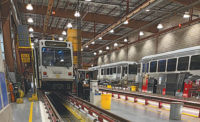BWI Concourse E Extension
Baltimore
Best Project
Owner: Maryland Aviation Administration
Project Developer: Parsons
General Contractor/Construction Manager: Allan Myers
Lead Design Firm: AECOM
The Concourse E project at Baltimore-Washington International Thurgood Marshall Airport converted an existing stormwater management pond into a parking area for commercial airline and commuter aircraft. The project team says the conversion was a key step toward creating a footprint for a six-gate expansion of the airport’s international terminal.
Each of the $19-million project’s 12 phases had to be planned and coordinated to allow construction activity and the airport’s near-constant ground operations to coexist safely and with minimal disruption, the team says. Working amid aircraft and ground vehicles required a safety approach going beyond measures taken at typical jobsites, the team says. Site-specific safety and training efforts covered everything from fall protection and airfield security to compliance with state aviation agency’s vehicle operation requirements for active airfields. “A high-level approach to safety was taken,” one safety judge noted.
Because the elements of each phase evolved and changed as work progressed, the project team needed to be nimble to adapt quickly without risking safety shortcuts. Designated employees were authorized to speak directly with BWI’s control tower to coordinate airfield access, which prevented communication lapses that could create otherwise avoidable hazards. Other measures, such as performing most of the concrete paving during early morning hours, helped reduce the risk of operational conflicts.
The project team’s strict training policy, called Don’t Know, Don’t Care, emphasized a personal approach to safety awareness. If a worker “didn’t know” about a potential safety issue, he or she would receive immediate remedial training from supervisors and safety professionals. Trained workers who “didn’t care” to follow safety requirements would be sent home for the day. They would receive an explanation from a supervisor about the importance of the specific practice. During 55,500 staff hours, only one person was sent home for the day. Another judge called the initiative “a great behavior-based solution for infractions and rapid growth of a culture of caring amongst the employees.”
By encouraging workers to proactively look out for themselves and each other, the construction team says it completed the project without an injury.
Along with setting a new benchmark for safety management, the project is also a model for environmental protection and innovation, the team says. Converting the stormwater pond to an airport apron required connecting numerous drainage outlets with newly installed oil/water separators, then linking those discharges to a new 2,780-ft-long, 66-in.-dia outlet storm drain. The drain installation began in the middle, rather than at the lowest end of its route—the typical practice—so that ground traffic from the last-minute addition of a new commuter airline at BWI could be accommodated.
Approximately 20,000 sq yd of concrete pavement was installed in formwork, which was checked by precision surveys before placement. That approach eliminated edge slump and resulted in zero rework because of thickness or grade inconsistencies, the team says. The on-time, on-budget completion of the Concourse E project laid the groundwork for a six-gate expansion that will enable BWI to keep pace with growing demand for overseas service when it begins operation.
Related Article: ENR MidAtlantic's 2018 Best Projects: Region’s Top Work Sets High Bar






